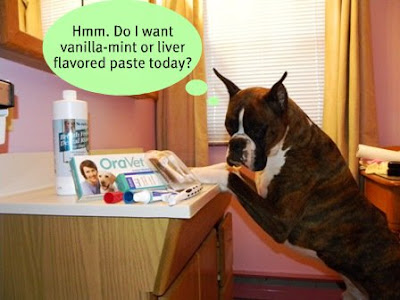Ah yes, the sweet smell of puppy breath. But what happens when that sweet scent fades? If proper steps aren’t taken, you may very well end up with dastardly dog breath. And, not only can the smell become offensive, improper dental care can lead to gum disease and ultimately more serious health problems.
Newman demonstrates proper dental hygiene
In case you didn’t know it, every year February is Pet Dental Health Month as a way to remind owners of the importance of proper dental care. Although we dogs rarely get cavities, we are prone to gum disease and excess tartar buildup on their teeth. Food particles and bacteria collect along our gum lines forming plaque. Routine home care can help remove this plaque.
As the Dog Scout Owner’s Motto states, “Our dogs’ lives are much shorter than our own, so let’s help them enjoy their time with us as much as we can.” Healthier teeth mean healthier dogs, so why not help prolong the lives of your canine companions by giving them proper dental care? My mom does.
Here are a few tips that I’ve picked up along the way to help curtail ghastly dog breath:
- Enzymatic toothpaste (such as CET) – Mom loves the smell of my fresh mint-vanilla scented breath after brushing with it. Even if you aren’t a great brusher, toothpaste like CET contains an enzyme that inhibits the formation of calculus on your teeth. Never use human toothpaste. Other tasty flavors include liver, chicken, and beef. See your vet for a tube today!
- Dental chews – While not as good as brushing, dental chews work by scraping the teeth clean during the chewing process, and also contain an enzyme that inhibits plaque.
- Dental rinse – If you’re a belligerent bully and detest brushing and chewing, consider doggy dental rinse. Believe me, I know about bullies. I live with two – my brother, Roger, and sister, Thelma Lou. Again, never use human dental rinse.
The goal of brushing is to brush the outside surface of teeth in area where teeth and gums meet. Training your dog to have his teeth brushed is no different than leash training. It takes time and patience. Most importantly make sure that each step is perceived as enjoyable and non-threatening by your pet, so don’t forget to load on the praise along the way. I just love hearing, “Good boy, Newman!”
Tips on the brushing process:
- When introducing brushing, limit the session to no more than a few seconds, then discontinue the session. Start by rubbing your bare finger along the gums. Do this for a few seconds and build up to longer periods of time.
- Add some dog enzymatic toothpaste to your fingertip and massage gums.
- Apply some dog toothpaste to a pet toothbrush and brush outer surfaces of teeth and gums.
Don’t be a victim to stink breath. Have your owners take steps to prevent it.


1 comment:
Typo for you to correct:
See you vet for a tube today!
Post a Comment